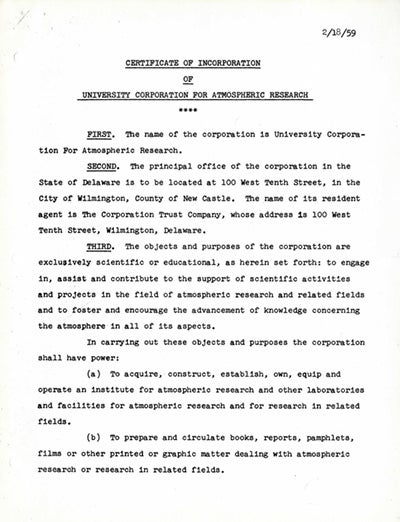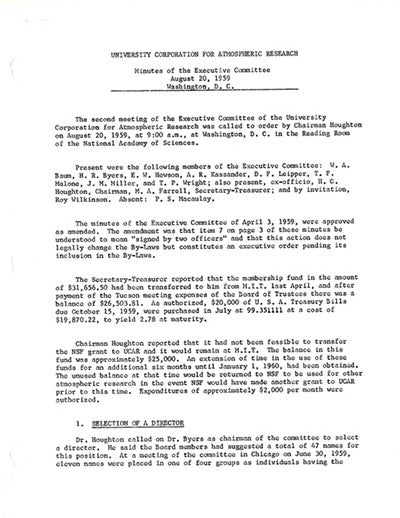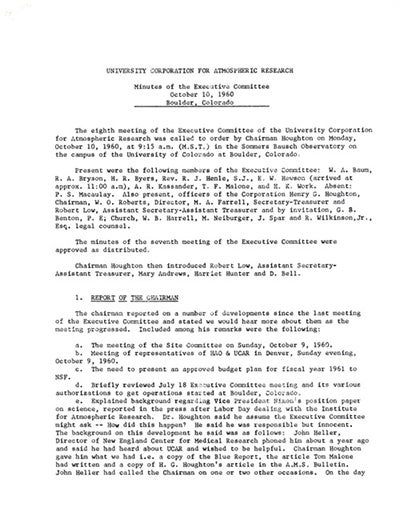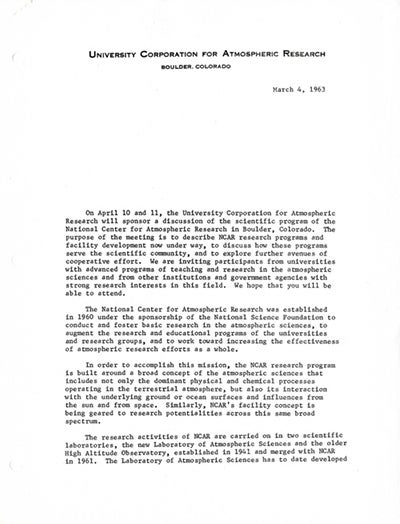UCAR's Beginnings
Digital Collection
The beginnings of NCAR and UCAR are detailed in this digital collection of unique materials. There are more than 60 original documents created during the infancy of UCAR and NCAR, including correspondence and official meeting minutes.
Following a report issued by the National Research Council in 1958 about the lack of research performed on the earth's atmosphere, the science community decided to establish a national institute devoted to atmospheric sciences. In February of that year, the first meeting to establish the institute (originally called the National Institute of Atmospheric Research) took place, during which the University Committee on Atmospheric Research (UCAR, now the University Corporation for Atmospheric Research) was appointed to oversee the process.
Over a period of several years, UCAR secured funding from the National Science Foundation, as well as the interest and involvement of multiple universities, selected a site for the facility in Boulder, Colorado, and appointed leaders for the institute. By 1960, the institute (by then called the National Center for Atmospheric Research) began operations, though UCAR's work was not complete. UCAR continued to call regular meetings to discuss the leadership of NCAR and its long-term plans.
The UCAR's Beginnings digital collection contains more than 60 original documents created during the infancy of UCAR and NCAR, including important correspondence and official meeting minutes.
Check out a selection of documents from the collection below and then browse the full collection.
| Document | Description |
|---|---|
|
This document contains UCAR's Certificate of Incorporation, which provides fundamental information about the organization, including its full name, location, objectives, powers and limitations, and the names and residences of its incorporators. |
|
|
This document contains the minutes of the second meeting of the Executive Committee, held at the National Academy of Sciences, during which committee members addressed the following: the selection of a director, the selection of a site, a meeting with representatives of the NSF, Henry G. Houghton's meeting with Congressman Teague, the contract with NSF, the UCAR Fellowship Program, and public relations. Minutes of the executive Committee, August 20, 1959, Washington, DC |
|
|
This document contains the minutes of the eighth meeting of the Executive Committee, held at the University of Colorado, during which committee members addressed the following: the chairman's report, legal counsel's report, the employment of legal counsel in Colorado, the Site Committee's report, the appointment of an associate director, the director's report, the corporation's fiscal year, and the relationship between UCAR and the HAO. Minutes of the Executive Committee, October 10, 1960, Boulder, Colorado |
|
|
In this document, Walter Orr Roberts invites parties to participate in a discussion regarding NCAR's scientific programs, how they could serve the scientific community, and how NCAR can secure more support. |
1940s: Weathering World War II
Since military planes and ships were useless if caught in severe weather events, thousands of observers, forecasters, and weather officers were needed during World War II. Training programs were started in 1941 at five American universities and the U.S. Army Air Force to train the many new meteorological staff needed during the war.
As the need for highly trained meteorological staff grew throughout the war, academic programs began at many other universities. These partnerships between government and academia paved the way for the creation of NCAR.
1950: The Importance of Science
A growing awareness of the importance of scientific research spread through the United States after World War II because scientific discoveries and inventions had contributed significantly to the war effort.
NCAR’s development became possible when Congress created the National Science Foundation in 1950.
1950s: The Cold War Atmosphere
The atmospheric sciences had their own version of the cold war with a goal of outpacing the Soviet Union in predicting and possibly even controlling the weather.
To assess resources within the atmospheric sciences, The National Academy of Sciences convened the Committee on Meteorology in 1956. The committee members concluded that stronger support for basic research and training in the atmospheric sciences could increase the effectiveness of weather forecasters who, at the time, were often trained on-the-job.
1958-1959: The Need for a National Institute
Representatives from 14 American universities came together to form the University Committee for Atmospheric Research. They asked150 researchers what facilities would be needed to analyze fundamental questions in atmospheric science.
The consensus was that there was an overwhelming need for a national institute dedicated to atmospheric research that connected scientists throughout the country to aid scientific discovery.
1960-1961: The Birth of NCAR
In 1960, the University Corporation for Atmospheric Research (UCAR) was incorporated with 14 founding member universities and Walter Orr Roberts, then director of the High Altitude Observatory (HAO), was selected as both NCAR director and UCAR president.
One year later, NCAR received $450,000 from the National Science Foundation to fund the center.
1960-1967: A Home for Atmospheric Research
Site consulting engineers recommend Table Mesa as the home of NCAR and the UCAR boards of trustees unanimously chose Boulder as site of NCAR in 1960. The state of Colorado purchased the land for the NCAR laboratory and, in 1961 Boulder Colorado citizens approved the site for NCAR in a 4-1 vote.
Renowned architect I.M. Pei was chosen to design the new laboratory on Table Mesa and construction of NCAR’s new home was completed in 1967.



